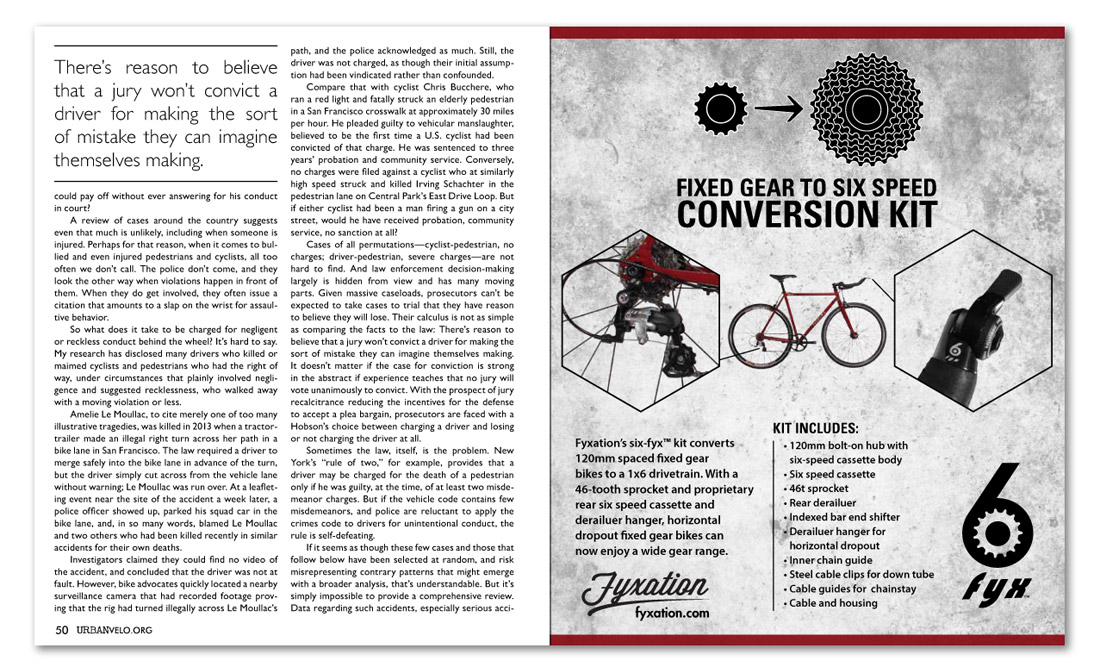


could pay off without ever answering for his conduct in court?
A review of cases around the country suggests even that much is unlikely, including when someone is injured. Perhaps for that reason, when it comes to bullied and even injured pedestrians and cyclists, all too often we don’t call. The police don’t come, and they look the other way when violations happen in front of them. When they do get involved, they often issue a citation that amounts to a slap on the wrist for assaultive behavior.
So what does it take to be charged for negligent or reckless conduct behind the wheel? It’s hard to say. My research has disclosed many drivers who killed or maimed cyclists and pedestrians who had the right of way, under circumstances that plainly involved negligence and suggested recklessness, who walked away with a moving violation or less.
Amelie Le Moullac, to cite merely one of too many illustrative tragedies, was killed in 2013 when a tractor-trailer made an illegal right turn across her path in a bike lane in San Francisco. The law required a driver to merge safely into the bike lane in advance of the turn, but the driver simply cut across from the vehicle lane without warning; Le Moullac was run over. At a leafleting event near the site of the accident a week later, a police officer showed up, parked his squad car in the bike lane, and, in so many words, blamed Le Moullac and two others who had been killed recently in similar accidents for their own deaths.
Investigators claimed they could find no video of the accident, and concluded that the driver was not at fault. However, bike advocates quickly located a nearby surveillance camera that had recorded footage proving that the rig had turned illegally across Le Moullac’s path, and the police acknowledged as much. Still, the driver was not charged, as though their initial assumption had been vindicated rather than confounded.
Compare that with cyclist Chris Bucchere, who ran a red light and fatally struck an elderly pedestrian in a San Francisco crosswalk at approximately 30 miles per hour. He pleaded guilty to vehicular manslaughter, believed to be the first time a U.S. cyclist had been convicted of that charge. He was sentenced to three years’ probation and community service. Conversely, no charges were filed against a cyclist who at similarly high speed struck and killed Irving Schachter in the pedestrian lane on Central Park’s East Drive Loop. But if either cyclist had been a man firing a gun on a city street, would he have received probation, community service, no sanction at all?
Cases of all permutations—cyclist-pedestrian, no charges; driver-pedestrian, severe charges—are not hard to find. And law enforcement decision-making largely is hidden from view and has many moving parts. Given massive caseloads, prosecutors can’t be expected to take cases to trial that they have reason to believe they will lose. Their calculus is not as simple as comparing the facts to the law: There’s reason to believe that a jury won’t convict a driver for making the sort of mistake they can imagine themselves making. It doesn’t matter if the case for conviction is strong in the abstract if experience teaches that no jury will vote unanimously to convict. With the prospect of jury recalcitrance reducing the incentives for the defense to accept a plea bargain, prosecutors are faced with a Hobson’s choice between charging a driver and losing or not charging the driver at all.
Sometimes the law, itself, is the problem. New York’s “rule of two,” for example, provides that a driver may be charged for the death of a pedestrian only if he was guilty, at the time, of at least two misdemeanor charges. But if the vehicle code contains few misdemeanors, and police are reluctant to apply the crimes code to drivers for unintentional conduct, the rule is self-defeating.
If it seems as though these few cases and those that follow below have been selected at random, and risk misrepresenting contrary patterns that might emerge with a broader analysis, that’s understandable. But it’s simply impossible to provide a comprehensive review. Data regarding such accidents, especially serious acci-
Fyxation